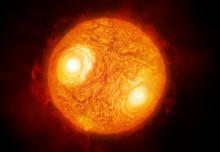Listen to today's episode of StarDate on the web the same day it airs in high-quality streaming audio without any extra ads or announcements. Choose a $8 one-month pass, or listen every day for a year for just $30.
You are here
Moon, Antares, Saturn
Early risers, take note: The crescent Moon will slide down past several bright companions over the next few mornings, creating some beautiful configurations in the pre-dawn sky.
First up are the star Antares and the planet Saturn. Bright orange Antares stands to the lower right of the Moon at first light, with golden Saturn about the same distance to the lower left of the Moon.
Antares and Saturn are among the few objects in the night sky to show any color. Antares looks orange because of its surface temperature — it’s thousands of degrees cooler than the surface of the Sun. Saturn, on the other hand, looks yellow because of the composition of its upper atmosphere.
The giant planet is a big ball of hydrogen and helium gas, with a tiny mixture of other chemical elements. Those elements combine to form layers of clouds at the top of the atmosphere.
The clouds in the top layer are made of ammonia. Those in the layers below probably are made of water, ammonia, and a compound that includes ammonia and sulfur.
These compounds are all white. But above Saturn’s visible cloudtops, several compounds react with sunlight to form hydrocarbons, which have an orange or red color. Tiny amounts of them fall into the ammonia clouds, adding a bit of color. When we see Saturn in the night sky, the colors blend together to give the giant planet a subtle golden hue — a rare bit of color in the starry night sky.
More about Saturn and the Moon tomorrow.
Script by Damond Benningfield




